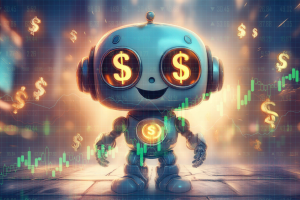
Tom Yeung here, with this week’s Sunday Digest.
Last week, I wrote how smaller companies tend to outperform when the U.S. Federal Reserve cuts rates. These firms are naturally riskier, and so having cheap money makes them more likely to survive.
That’s because borrowing money becomes cheaper…
Venture capitalists open their wallets…
Consumers feel more confident…
And the result is a predictable cycle where smaller, riskier companies do better than their larger peers. 2025 will likely become a big year for small-cap stocks.
This week, InvestorPlace Senior Analyst Louis Navellier points out that there’s another force pushing stocks higher:
A mega-cycle that’s being encapsulated by AI.
As he explains, the current AI boom didn’t happen overnight. In fact, Louis notes, it has quietly been built in the background, over a period of many years.
The mathematical tools that underly today’s large language models (LLMs) can trace their origins back to the 1940s. The chips that power AI today were developed in the 1990s. However, chips only became small enough within the past five years to allow the types of processing speeds needed to create today’s AI models.
When all these factors come together, you have change that’s far faster than anyone could have imagined.
That’s why he’s forecasting a seismic change in the U.S. economy, where knowledge workers and blue-collar ones will be replaced by increasingly smart machines. As Louis says:
I predict that sometime in the next five years, you or someone you know will be replaced by an AI-powered robot or an algorithm that does the job better. A lot of people over the age of 55 won’t have time to retrain and climb the corporate ladder once again, or to start a profitable business.
Fortunately, there’s still time to prepare. By combining the predictable cycle (small-caps outperforming) with the mega-cycle (AI companies dominating), it’s possible for people to invest with the flow, instead of against it.
And so, this week, I’ll be talking about three small-cap AI stocks that look set to surge in 2025. (Meanwhile, Louis recently recorded an event talking about this cycle convergence – he calls it the Real AI Boom – and which stocks his quantitative system shows could be among the biggest long-term winners. You can watch it by clicking here.)
The AI Customer Service Agent
A $2 billion firm that provides virtual contact center services for enterprises, Five9 Inc. (FIVN) provides cloud-based customer engagement tools across all channels (email, text, calls, social media, etc.), as well as AI-based analytics and automation. (In other words, customer service reps log onto Five9’s website and perform all their daily tasks from that centralized location.)
The sudden improvements in AI chatbots will make Five9’s offerings even more crucial. Most enterprises have little desire (or internal capability) to train accurate chatbots that won’t hallucinate, offend customers, or make promises they can’t keep. And so, we’ve seen a broad industry shift over the past several years toward firms like Five9 that allow enterprises to offload this function.
I see the next several years as pivotal for Five9. Appetite for AI-powered customer service tools is booming, and consumers are becoming more accepting of communicating with AI agents. We’re already seeing widespread use of hybrid models where basic AI-powered chatbots try answering questions before escalating to human agent. Over the next several years, Five9 will have the opportunity to offer increasingly sophisticated AI agents that could skip that second step entirely.
If they succeed, advanced AI capabilities will allow Five9 to upcharge for its services, which will increase margins as well as growth. In a recent William Blair investor conference, Five9 President Daniel Burkland said that he will be targeting 70% gross margins, up from 61% last quarter. That could flip the company to positive GAAP profits by next year, according to Wall Street analysts. Revenue growth is expected to hit 21% in 2025 and accelerate to 32% in 2026.
It’s important to note that Five9 also has no human-run customer call centers of its own. So unlike call center outsourcing firms turning to AI, Five9 will not face the type of restructuring costs that rivals will see.
Shares of Five9 traded as high as $200 during the peak of the Covid-19 pandemic when companies were shifting customer services functions into the cloud. In fact, Five9 shareholders rejected a $14.9 billion takeover offer from Zoom Video Communications Inc. (ZM) at the time because they felt the 13% premium was too low. Today, shares trade at under $30. Though growth has slowed in the post-pandemic period, it will likely pick up again as cyclical and secular trends – i.e., the Real AI Boom– come back together.
The Self-Driving Winner
This week, InvestorPlace Senior Analyst Luke Lango put it plainly in a Hypergrowth Investing update:
“We see mind-blowing profit potential ahead for self-driving car stocks.”
Alphabet-owned Waymo already provides 100,000 autonomous rides a week across four U.S. cities. Uber Technologies Inc. (UBER) will soon begin offering similar services starting next year. And on Thursday, Elon Musk’s Tesla Inc. (TSLA) announced grand plans for its robotaxi, which it’s calling the Cybercab.
“This progress is widespread,” Luke continues, pointing out advancements by firms from Aurora Innovation Inc. (AUR) to Kodiak Robotics. “We think it is entirely safe to say the age of automotive vehicles has arrived.”
That’s why I foresee Sensata Technologies Holding PLC (ST) doing well too.
Sensata is one of the key legacy U.S. automotive suppliers for electrical components and sensors. The company was spun out of Texas Instruments Inc. (TXN) in the mid-2000s, and is known for its flawless operating history.
This reputation for quality has paid off. Over the past 20 years, Sensata has earned operating margins a third higher than industry average by focusing on mission-critical components that are built to withstand harsh environments. The firm is a leader in electric vehicle battery management systems, for instance, since a failure in these high-voltage systems could be catastrophic. The company is also a leader in a variety of automotive sensors, including those that monitor fuel injection, tire pressure, and more.
The AI-powered self-driving vehicle revolution will provide a significant tailwind for this $5 billion firm. Autonomous vehicles have more sensors… more electrical components… more mission-critical components than their traditional counterparts. And these higher stakes mean that automakers will be relying on Sensata even more than they already do for electrical sensors and components. Analysts forecast revenue growth will accelerate from zero this year to 8% by 2026, and that earnings per share will rise twice as quickly thanks to greater value added.
Best of all, Sensata is priced at a steep discount and has a strong legacy business. Shares trade at under 10X forward earnings, giving it 50% upside on multiples expansion alone.
The AI That’s Replacing Workers
Finally, $7 billion UiPath Inc. (PATH) rounds out or list this week of small-cap stocks to buy for the Real AI Boom.
UiPath is a New York-based process automation firm that helps companies use AI to perform routine tasks. German-based utility company Soluvia Energy, for instance, used UiPath to automate much of its metering systems, reducing the number of manual transactions by 250,000 in its first year. Software firm MongoDB uses UiPath to produce revenue write-ups, a process that once took its teams over a week to complete. (The process now only takes a few hours.)
Previously, UiPath suffered from the same issues that traditional business process outsourcing (BPO) firms face: Contracts were generally lowreturn because of their focus on low-value tasks like data extraction, form filling, and updating databases. That made it difficult for UiPath – and any player in the BPO industry – to upcharge customers and generate profits. According to Refinitiv, the median return on equity in the sector is currently 0.0%.
Fortunately, UiPath is beginning to benefit from improved AI capabilities. Advancements in AI now mean that more complex tasks like insurance claims processing and appointment scheduling is becoming good enough for widespread use. More advanced cognitive tasks like loan underwriting could be next.
That should provide a boost to UiPath’s profitability over the coming years. Analysts expect reported losses per share of $0.30 should decrease to $0.26 next year, and the company could achieve GAAP profitability by the end of the decade.
Earlier this week, Louis noted that the dockworkers’ strike might be over, but AI is still coming for their jobs. It’s increasingly clear that investing in companies like UiPath would be the “insurance” for this likely future.
The Real AI Boom
Louis notes that large language models like ChatGPT are essentially the first generation of AI. Much like early-1990s websites, these chatbots are only exploring how a new technology could change the world.
No one’s making money from them.
In fact, ChatGPT owner OpenAI is set to lose $5 billion this year. (AOL and its peers were burning cash at similar rates at the peak of the dot-com bubble.)
That’s why Louis believes there will be a coming “reset” in stocks where some of the least likely AI stocks go on a massive bull run, while previously popular AI stocks face a correction (or spend the rest of 2024 going nowhere).
He’s calling this the Real AI Boom.
Be sure to watch his presentation here.
I’ll be out of the office next week, so I’ll see you again in two weeks.
Thomas Yeung
Market Analyst, InvestorPlace




